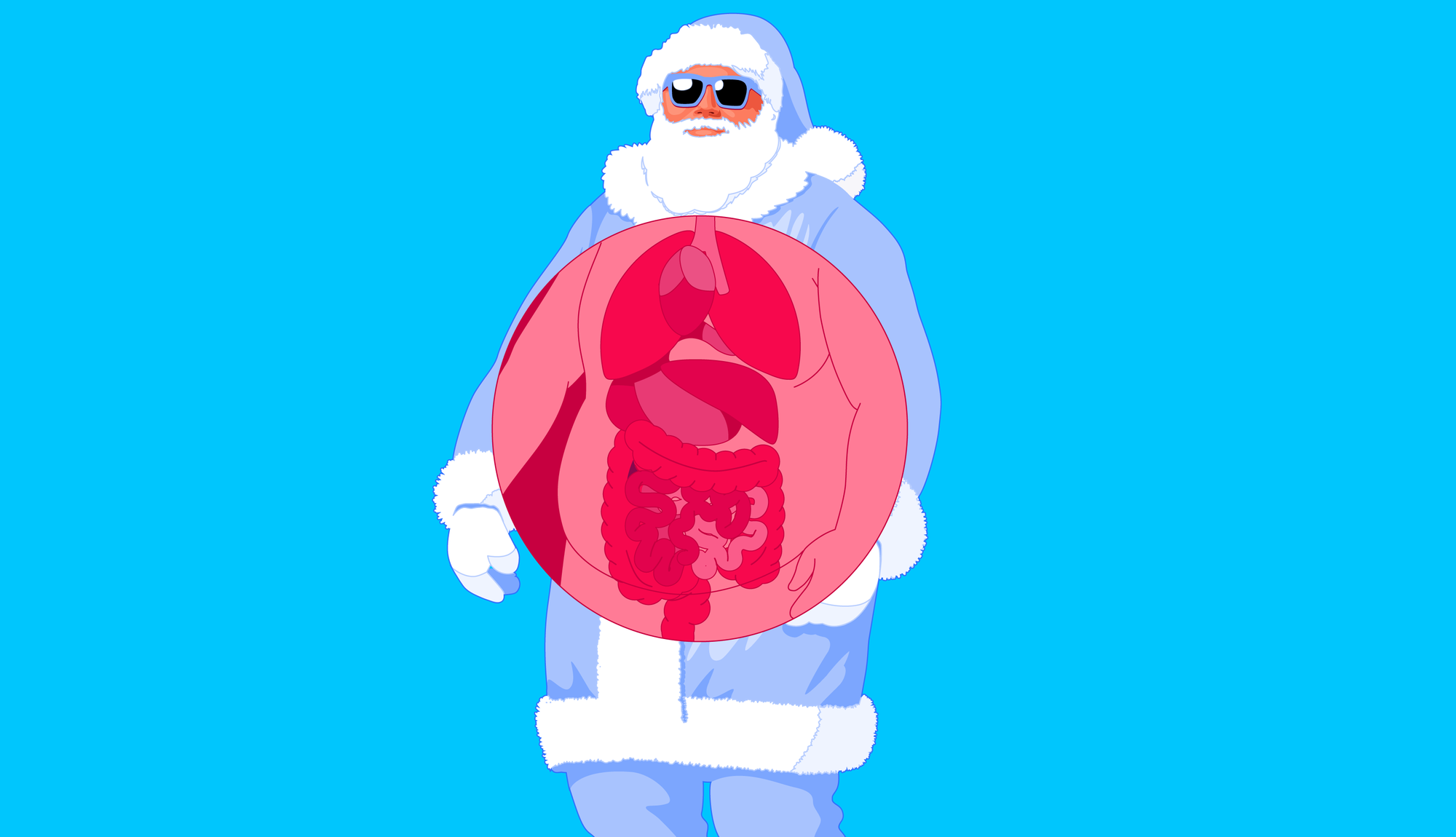Every Christmas, children the world over leave food for Santa on the mantelpiece. Depending on where you are on the map, this might be mince pies and sherry (United Kingdom), milk and cookies (USA), beer (Australia), rice pudding (Denmark), coffee (Sweden) or Guinness and a carrot (Ireland).
Suffice to say, Santa is not getting much prebiotics (unless he eats the reindeer’s carrots) and is undoubtedly exceeding his weekly intake of alcohol, judging by those rosy cheeks. Assuming Santa’s diet is like this all year round, what would his microbiome look like?
Table of contents
- Santa and his little helpers: The Atlas Microbiome Test
- Microbiome diversity score
- Butyrate potential score
- Enterotype: classic Western Gourmand
- Food Recommendations: New Year, new Santa
Santa and his little helpers: The Atlas Microbiome Test
Let’s imagine Mr and Mrs Claus have been reading about the importance of the microbiome and want to know more about the little helpers that live in our gut. After scouring the internet for deals, they have decided that they want to take the Atlas Microbiome Test.
As the Claus' love a bargain, they opt for the Atlas DNA and Microbiome Test bundle, saving themselves a healthy £150. 4-8 weeks later, their results are uploaded and ready to review. Mr Claus sits on the sofa, pours a glass of sherry and checks his report. According to his gut microbes, he’s been naughty, not nice.

Microbiome diversity score
Diversity is measured by the balance and richness of your microbiome; the more species that are present in your gut, the better. Unfortunately for Santa, his diversity score is woefully low due to a lack of dietary fibre and plant-based foods.
This means that Santa has low numbers of beneficial bacteria and is missing important species, something known as dysbiosis. An imbalance of the microbiome is associated with type 2 diabetes, inflammatory bowel diseases and brain fog, among other issues.
Butyrate Potential report
Butyrate is an essential short-chain fatty acid produced by certain bacteria in the gut. Not only does it possess antioxidant properties, but it also fuels the cells in the gut lining and stimulates the growth of villi, thereby reducing inflammation. Butyrate can also deter opportunistic bacteria.
The bacteria in our gut make butyrate when they ferment fibre our body cannot digest. These indigestable fibres are found in complex carbohydrates such as fruit, vegetables and whole grains. Due to a lack of dietary fibre, Santa’s butyrate score is as low as his diversity, putting him at risk of low-grade inflammation and inflammatory diseases. Bacteria that are known to produce butyrate by fermenting fibre include:
- Firmicutes phylum
- Anaerostipes
- Faecalibacterium
- Roseburia
- Eubacterium
- Gemmiger.
Enterotype: classic Western Gourmand

Large-scale studies of the microbiome have identified that our long-term eating habits produce stable clusters of bacteria, known as “enterotypes”.
Though there is some controversy around this idea, many scientists entertain the likelihood that there are three to four enterotypes, made up of the bacterial genera Prevotella, Bacteroides and Ruminococcus.
Without a doubt, the Bacteroides genus dominates Santa's gut microbiome, making him a Western Gourmand. This enterotype is associated with a high intake of animal protein, fats and refined sugar. For this reason, some have suggested that it reflects the Western Diet.
Considering the arctic geography of the North Pole, it would make sense that Santa's microbiome is dominated by this genus. Interestingly, Canadian Inuits have also been shown to have broadly similiar microbiomes to those eating a Western diet in Montreal, likely due to their low fibre and high fat diets. With that being said, there are some significant differences in the levels of certain species.
Recommendations: New year, new Santa
Luckily for Santa, he has received personalised food recommendations to boost beneficial bacteria, increase microbial diversity, encourage butyrate production, and harness the power of his gut microbes. It might be one of the most important lists Santa reads this year! He can even track his dietary changes with our award-winning meal tracking technology..
Among his nutritional recommendations, he has been advised to eat 200g of fruit and vegetable each day, incorporate foods rich in Omega 3, limit his intake of red meats (read: fewer mince pies) and avoid trans-fats.
Whilst awaiting his DNA and Microbiome results, Santa completed the lifestyle questionnaire, a list of questions screening for environmental and lifestyle risk factors. Based on these data sources, he has received a long list of actionable health advice, including:
- Do more physical activity
- Spend less time sitting down
- Minimise your alcohol intake each week
- Eat more fibre
- Eat more fermented foods
- Limit intake of sweets and baked goods
All of these recommendations are fully supported by the most recent research: a sedentary life is associated with an increased risk of cardiovascular diseases, whilst exercise can improve sleep, boost mood and reduce the risk of multiple diseases. By eating more fibre and fermented foods, Santa will encourage beneficial bacteria in his gut microbiome, reducing inflammation and supporting his immune system.
Overall health report:
To summarise Santa’s results, his microbiome report says he lacks diversity and butyrate; his lifestyle questionnaire says he needs to sit less and exercise more; his nutrition report says he needs more fibre and less baked goods, and Mrs Claus says she has been telling him this for years.
















